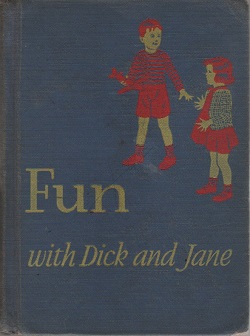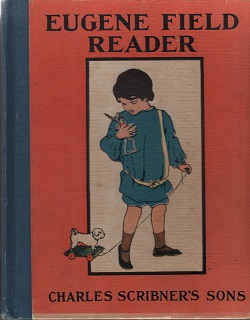|
Remember the excitement you felt when you first started
reading by yourself? How proud you were when you read to a willing
listener? Maybe you practiced reading the same book over
and over. Or perhaps you soon wanted more words and more stories. Whether
new readers start slowly or take off in a flash, there are many
books for them to choose from.
For many
years, children learned to read from primers, a type of first text
book that included alphabet books and later, basal readers. Basal
readers were a change from the earlier primers. They began in the
mid-19th century with the McGuffey Readers. They were based on
phonics, the sounding out of letters and words, and were organized
in levels to teach specific skills, from beginning to more
complicated. After World War I, reading
experts began pushing for changes. The Scott, Foresman Company
developed new readers that included the suggestions of the
experts. In 1930,
they began publishing the Dick and Jane series. The stories
featured the same characters in everyday activities. They used a
whole word or sight word method, which became known as
"look-say." Simple words were repeated often, and the
pictures helped the reader connect the word with its
meaning. The Dick and Jane Books were
widely used into the 1970s and were probably the most famous basal
readers ever. However, problems developed in the 1950s, largely due
to the book Why Johnny Can't Read by Rudolf Flesch. Flesch
believed that the vocabulary was limited and the stories were
overly simplistic. While children learned to read with
the Dick and Jane series, critics thought the books were boring. Much debate developed in the country
over whether they were turning children off to reading.
Many wanted books that were more fun. In
1955, Dr. Seuss (Theodore Geisel) was asked by William Spaulding
of Houghton Mifflin to "write me a story that first graders
couldn't put down." But Geisel was under contract with Random
House, so the two companies came to an agreement. Houghton Mifflin
would publish the education edition for the classrooms, and Random
House the trade edition for bookstores. In early 1957, The Cat in the
Hat hit the market. It was an instant success, especially for
Random House, and led to the creation of the Beginner Books
imprint. That same year, Harper & Row published Little
Bear by Else Holmelund Minarik,
the first title in their I Can Read series. The "modern"
easy reader was born. Other easy readers
soon followed, with different
publishers having their own style. Within these lines of easy
readers, there are usually several levels, from the very easiest
books with only a few words on a page, to the higher levels,
sometimes with chapters, for the more accomplished reader.
Whatever these books are called, Easy Readers . . . Beginning
Readers . .
. Emergent Readers . . . they are familiar to us all and
remind us of those exciting moments when we were first learning to
read. Over the
years I have collected an assortment. Many titles are from the
well known trade publishers. Others include lesser known titles
from some of the curriculum publishers in the education market, as
well as a few earlier primers/basal readers. I hope you
enjoy the memories as you browse through the fun variety of
stories and illustration styles.
- Kathy
(Easy Readers Con't)
Early Readers
1950s 1960s
1970s 1980s 1990s
2000s
2010s
***********************************
|


